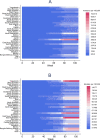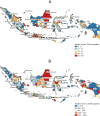Geographical variations and district-level factors associated with COVID-19 mortality in Indonesia: a nationwide ecological study
- PMID: 36641453
- PMCID: PMC9840537
- DOI: 10.1186/s12889-023-15015-0
Geographical variations and district-level factors associated with COVID-19 mortality in Indonesia: a nationwide ecological study
Abstract
Background: Ensuring health equity, especially for vulnerable populations in less developed settings with poor health system is essential for the current and future global health threats. This study examined geographical variations of COVID-19 mortality and its association with population health characteristics, health care capacity in responding pandemic, and socio-economic characteristics across 514 districts in Indonesia.
Methods: This nationwide ecological study included aggregated data of COVID-19 cases and deaths from all 514 districts in Indonesia, recorded in the National COVID-19 Task Force database, during the first two years of the epidemic, from 1 March 2020 to 27 February 2022. The dependent variable was district-level COVID-19 mortality rate per 100,000 populations. The independent variables include district-level COVID-19 incidence rate, population health, health care capacity, and socio-demographics data from government official sources. We used multivariable ordinal logistic regression to examine factors associated with higher mortality rate.
Results: Of total 5,539,333 reported COVID-19 cases, 148,034 (2.7%) died, and 5,391,299 (97.4%) were recovered. The district-level mortality rate ranged from 0 to 284 deaths per 100,000 populations. The top five districts with the highest mortality rate were Balikpapan (284 deaths per 100,000 populations), Semarang (263), Madiun (254), Magelang (250), and Yogyakarta (247). A higher COVID-19 incidence (coefficient 1.64, 95% CI 1.22 to 1.75), a higher proportion of ≥ 60 years old population (coefficient 0.26, 95% CI 0.06 to 0.46), a higher prevalence of diabetes mellitus (coefficient 0.60, 95% CI 0.37 to 0.84), a lower prevalence of obesity (coefficient -0.32, 95% CI -0.56 to -0.08), a lower number of nurses per population (coefficient -0.27, 95% CI -0.50 to -0.04), a higher number of midwives per population (coefficient 0.32, 95% CI 0.13 to 0.50), and a higher expenditure (coefficient 0.34, 95% CI 0.10 to 0.57) was associated with a higher COVID-19 mortality rate.
Conclusion: COVID-19 mortality rate in Indonesia was highly heterogeneous and associated with higher COVID-19 incidence, different prevalence of pre-existing comorbidity, healthcare capacity in responding the pandemic, and socio-economic characteristics. This study revealed the need of controlling both COVID-19 and those known comorbidities, health capacity strengthening, and better resource allocation to ensure optimal health outcomes for vulnerable population.
Keywords: COVID-19; Coronavirus; Epidemiology; Indonesia; Mortality; Pandemic.
© 2023. The Author(s).
Conflict of interest statement
The authors declare no competing interests.
We declare no competing interests.
Figures




References
-
- World Health Organization. WHO Coronavirus Disease (COVID-19) Dashboard. Available: https://covid19.who.int [Accessed 30 December 2022].
-
- World Health Organization . Strategic preparedness, readiness and response plan to end the global COVID-19 emergency in 2022. Geneva: World Health Organization; 2022.
Publication types
MeSH terms
Grants and funding
LinkOut - more resources
Full Text Sources
Medical

